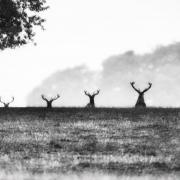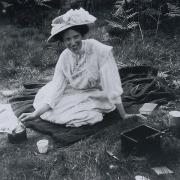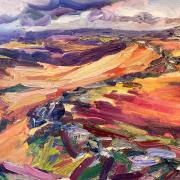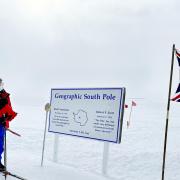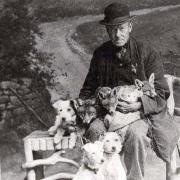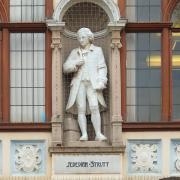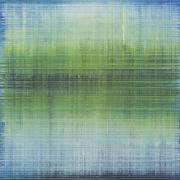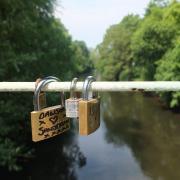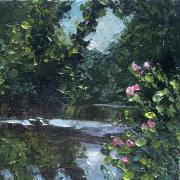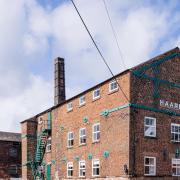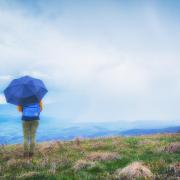The Hathersage-based photographer/artist.
Is photography art? If you type this question into the internet search engine Google, there are nearly 15,000 entries. As a photographer, I was pleased to see that most of the entries I checked answered with a resounding 'Yes'. The few detractors argued that all a photographer has to do is 'press a button' or 'point and shoot'. Counter to that, one of the more considered arguments pronounced that 'One should not judge art by the tools one uses but by the outcome and the effect it has on your mind.' Even better was the argument that 'It is not the subject, the level of technology nor the talent that makes art. It is the intent of the person. If a photographer's intent is to create a piece of art, then who is anyone to say that it is not?'
The advent of digital photography and concomitant software like Photoshop has brought exciting ways to manipulate a photographic image and create imagery of impressive artistry. After 'painting with light', a photographer can now paint with pixels. As someone who produces 'photo art' in this way, I was greatly cheered two years ago to see the Tregoning Art Gallery in Derby showcase photography for the first time. It was the work of Hathersage-based artist/photographer Anthony Marshall.
Anthony's Liquidlight series of watery reflections was a set of beautifully colourful, contemplative images that captured light reflected off the surface of water. What made it even more special was that the photography was pure and unadulterated. It was heartening to hear also that in his 30 years as an art photographer, Anthony's work has been showcased in 40 exhibitions across the UK and, remarkably, all have been in art galleries. His work is also housed in many private collections around the world.
What of Anthony's view of photography as art? 'For photography to be taken seriously as art, photographers must, at all times, try and produce truly original work and think like an artist,' he declares.
This is certainly true of Anthony's latest work. The whole concept of photography as art has taken a step forward with his 'Derbyshire Landscape' images on view at Bakewell's Ridgeway Gallery. Anthony has created the perfect expression of photo art by literally combining painting with photography. He has applied paint over a choice selection of his photographs, attempting 'to explore the visual relationship between photography and painting.' His picture 'Sunset' is a photographic image with a painterly look - or is it a painting with a photographic look? Either way, it's a striking piece of imagery. Having seen his straight photograph of a snowy corner of the Chatsworth Estate from his book Facets of Light, I am impressed by the way his 'over-painting' has heightened the image. Likewise his application of paint on some of the Liquidlight photographs has unquestionably achieved his aim of 'enhancing the colour and textural quality of the surface.'
The power and potency of the original photographic image is what makes these paintings so captivating. A completely self-taught photographer of 30 years standing, Anthony was a late developer. He wanted to be a photographer from the age of 12 but didn't start on this career path until he was 30. He reflects on the risk he took: 'I had a well-paid job as principal of a psychiatric day centre with responsibility for 150 patients and staff, and I had a family and mortgage. But I was so consumed with a desire to be a photo artist that I upped and left. My aim was to sell my work to galleries - and I soon got an exhibition with my early Liquidlight photographs - but to earn a living I became a commercial landscape photographer. Making a living as a photographer is a challenging business, particularly if you specialise, but I managed to place my imagery with several photo libraries and eventually I was selling my pictures in over 50 countries. It was still a precarious existence, though, and I continued to hope that I could eventually concentrate on photo art.'
It was ten years before Anthony's breakthrough, which came when his echnical skill as a photographic printer brought him to the attention of Fuji in Japan. 'They asked me to help them with a new technology,' he recalls. 'They had developed a huge machine where you could transfer a colour image on to textile. It was seriously crude at the time, but I still managed to produce some appealing photo art for restaurants and hotels. That was the start of my really creative work.'
More art-based work was to come, this time from a source much closer to home. Anthony's photo art was selling well in the Chatsworth shop and this came to the attention of the Duchess, who invited Anthony to assist on a large and fascinating commission. 'It was essentially a huge art licensing project,' explains Anthony. 'I had the intriguing job of assessing all the treasures of Chatsworth to find imagery that could be recycled into licensing opportunities to develop modern day products and therefore earn royalties for the Chatsworth Trust. For three years, I was privileged to have the unique opportunity of looking through a marvellous collection, which included 2,000 old masters and 1,000 paintings as well as tapestries, furniture, china, jewels, bronzes, carpets, silver, sculpture and rare books. I was amazed to find that Chatsworth houses 50,000 books, making it the second biggest private library in the world. It's also got one of the world's great collections of hand-painted books plus some wonderful illuminated manuscripts and sumptuously illustrated flower books from the golden age of botanical illustration. Some of these books are so large that it takes two people to lift one volume! I had to use my skills to find aspects of all this imagery that could be turned into greeting cards, gift wraps, wallpapers, coasters and so on. Royal Doulton did a series of porcelain ceramics and we had textile designs sold at both Marks & Spencer and Laura Ashley.'
Around the same time, Anthony also found work photographing original artworks for museums, private collectors, artists, galleries and book publishers. This enabled him to pursue more of his personal projects, including his cherished Liquidlight series. These works in particular make a case for photography as art. The doubting Thomas who contends that a photographer merely fires a shutter doesn't take into account the processes prior to firing that shutter. As the legendary landscape photographer Ansel Adams so famously declared: 'You don't take a photograph. You make it.' In Anthony's case, he observed how water 'had the ability to change state easily and is always on the move', so knew that his images would be uniquely 'of the moment'. His photographs attempted to 'capture natural abstract designs from the fleeting moment when light is reflected off the surface of water.' However, successfully capturing a fleeting moment was only achievable with considered and specific conditions. The beautiful simplicity of Anthony's watery reflections belies the extraordinary lengths he went to in order to create this imagery: 'These were always difficult images to produce because they were dependent on windspeed, direction of the sun and the right water conditions,' he points out. 'All these needed to be in place before the final and most difficult element was added - strong colour. Even then there is the complex issue of composition and balance of the final image. Water is constantly on the move, generating a bewildering variety of natural effects. Isolating just one of those fast-changing water designs requires considerable experience and knowledge of the natural world together with some good luck. Like the impressionist painters, I visit my locations over and over again, at different times of the day and year. I also use very long lenses which gives me the ability to compress the perspective and concentrate the viewer's attention on specific parts of the scene and also give the viewer the illusion of depth. If you look at my latest work, you'll see that the illusion of depth has been further enhanced by the application of paint, and in the Liquidlight images this is taken to the extreme by completely flattening the perspective, using the texture of the paint to concentrate on the important shapes and colours.'
Another reason why Anthony was keen to explore this 'painting over' process was that he was getting bored with his exhibition work. 'I have a low boredom threshold,' he admits, 'and I wanted to try something new. I had done painting in the past but because I can't draw I thought I would use my photographs. My pictures have always been very painterly anyway so I decided to see if I could apply paint to the image but retain all the quality of the original photograph. I also thought that by doing this, I would take photography to another level.'
Anthony admits that his methodology is not much different to that of a painter who uses a photograph to compose a painting. Although his photographs provide the composition of the final painting rather than mere reference points. Anthony is also excited by the contemporary nature of his work: 'When I give lectures at universities and art colleges students involved in photography see it as part of their mixed media. For them, photography is a medium they mix with other media in order to create another artwork. That's where photography seems to be going, so I've helped start that ball rolling.' Anthony is heartened to be producing work that can be viewed as highly contemporary: 'I'm 62 and yet I'm still producing work that will sell in commercial galleries. In fact, I've never been more creative and I just love the idea of competing with youngsters straight out of college!'
Sarah Ridgeway has no doubts that Anthony's work will sell in her Bakewell gallery: 'I love Anthony's new work for the way it combines the skill of the photographer with the interest achieved by all the different paint effects built up within his paintings. You can see the photographer's art in the fleeting, piercing play of light through the trees at dawn or the fragment in time that results in the reflection of a bright dress creating the dramatic contrast in colours in the rippling water. You also see how his painting technique adds texture to the moss covering the rocks at the foot of Padley Gorge or enhances the blossom on the trees. In a sense, you get the best of both worlds and I feel any lover of art will be fascinated and enthralled by this impressive imagery.'
For his next set of images, Anthony will be devoting a lot of time this autumn to the aforementioned Padley Gorge, which isn't far from his Hathersage home. 'Derbyshire is a difficult place to photograph because of the weather conditions,' he states, 'but the last two autumns here have made the place feel more like New England than Derbyshire, and those glorious saturated colours look wonderful in Padley Gorge. It's one of the few remaining ancient oak woodlands left in this country and in the late autumn/early winter, the moss-coloured boulders are almost iridescent. At the same time, I'm planning to take my painting to another level: having painted over my photographs on art paper, I am now planning to use canvas, which I'm sure will make my pictures even more painterly. After 30 years, it feels as though I'm having a new lease of life.'
'A Derbyshire Landscape' can be seen at the Ridgeway Gallery between 28th October and 18th November. Anthony's books - Facets of Light, Liquidlight and Landscape in Design can be purchased on the internet www.blurb.com. Click on Book Shop, type in 'Anthony Marshall' and his books will be displayed.



